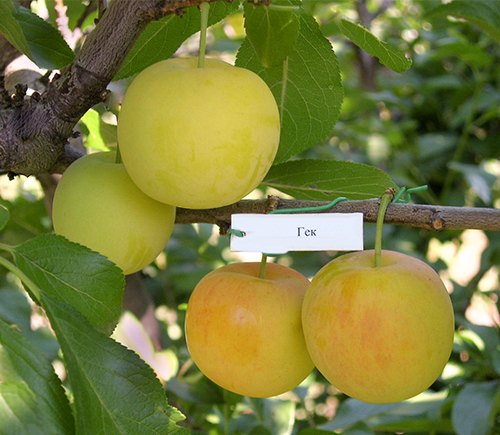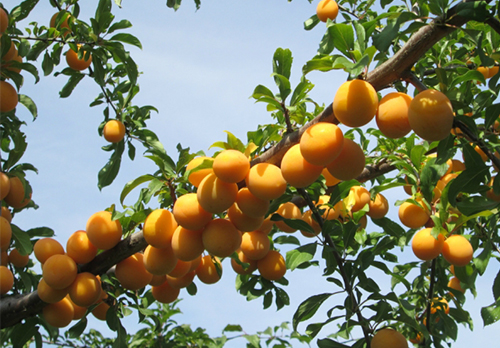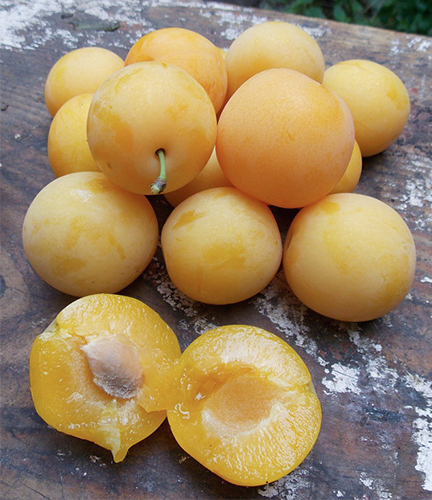Cherry plum variety Gek
Gek - a variety of Alycha hybrid, or Russian Plum (Prunus rossica), medium ripening, obtained by hybridization of the Chinese Plum variety (Prunus salicina) Early with cherry plum varieties Otlnitsa. Place of hatching - Crimean experimental selection station of the All-Russian Research Institute of Plant Industry named after V.I. N.I. Vavilova (Krasnodar Territory). The authorship belongs to G.V. Eremin and S.N. Zabrodina.

Photo by: Lyudmila Redchenko, Kiev region
In 1991, the variety was sent for state testing. In 1995 it was entered into the state register of plants of the Russian Federation. Approved for use in the North Caucasian and Lower Volga regions.
The trees are medium-sized, fast-growing, with a flat-round, medium-thickened crown. The stem is even, of medium thickness, gray in color, with few large lenticels. The shoots are thick (30 - 35 mm), the lentils are found on them in an average amount. The vertical position, which is inherent in the shoots at the beginning of growth, eventually becomes horizontal. Growing shoots are colored in an intense anthocyanin color, but their tops are not colored. Overgrowing twigs (bouquet) are short-lived (1 - 3 years), have a short length. Flower buds are small, adpressed, rounded; at the blossoming buds, the scales are colored green. The leaves are large (7.4 cm long, 4.3 cm wide), elongated-oval, with a wedge-shaped base and a strongly pointed tip; the edge of the leaf is medium-wavy, with double-gable serration. The leaf blade during growth is directed upward, from above it is moderately shiny, colored green, from below it is very slightly pubescent. The glands are located at the base of the sheet. The petioles are thin (1 mm), of medium length (1.5 - 1.6 cm), with deep grooves, the color is intense anthocyanin.

Inflorescences are two-flowered, there are many of them on the shoot. Flowers of medium size (diameter 2 - 2.2 cm). Petals are white, medium in size, ovoid, slightly closed, moderately corrugated, the edge of the apex is moderately wavy. Numerous stamens (28 pcs / color), slightly curved in shape, filaments 2 - 5 mm long, yellow anthers. The stigma is oval, located above the level of the anthers, the column of the pistil is slightly curved, 1 cm long. The ovary is glabrous. Pedicels are thin, of medium length (1.1 cm). The calyx is bell-shaped; pubescence is absent. Sepals are oval, slightly curved, 0.4 cm long, 0.3 cm wide.
Cherry plum fruits are large in size (average weight 28 - 31 g, maximum - 45 g; length - 4.1 cm, width - 3.7 cm, thickness - 3.7 cm), slightly asymmetric, broad-ovoid or rounded-oval, with a rounded apex, the largest diameter is located closer to the base of the fruit. Funnel of medium depth. The abdominal suture is even along the entire length, clearly expressed. The skin is of medium thickness, dense, elastic, with a waxy bloom of medium density, it is difficult to separate from the pulp. The main color of the fruit is yellow, the integumentary color occupies up to 25% of the surface in the form of an orange-pink blush. The subcutaneous points are few in number, colored yellow.

Photo by: Lyudmila Redchenko, Kiev region
Small or medium-sized bones (weight 1.19 grams, 3.91% of the total weight of the fruit, length - 2.5 cm, width - 1.4 cm, thickness - 1.4 cm), oval, from the side of the abdominal suture elongated-elliptical, symmetrical, widest in the middle. The base of the stone is of medium width, slightly concave in shape, the apex is pointed. The abdominal suture is of medium width. The merging of the edges of the continuous seam is partial, integral. The surface is smooth. The keel is not developed. The separation of the bone from the pulp is poor. Peduncles are thin (1.5 mm), medium length (12 mm), not pubescent.
The pulp is not juicy, of medium density, fine-grained structure, gristly, colored yellow, sugar content and acidity are medium, the taste is good, sour-sweet (with a predominance of sweetness). On the cut, the pulp darkens slightly in air. Tasting assessment of fruit taste - 4.2 points, juice with pulp - 4.5 points, jam - 4.5 points, compote - 4.4 points.The biochemical composition of fruits (raw weight) is as follows: dry matter - 11.7%, total sugars - 8.3%, acids - 2.4%, ascorbic acid - 5.1 mg / 100 g. for fresh consumption and are perfect for canning (compotes, jam, jams). Fruit transportability is high.

Photo by: Sergey Gladkiy, Kharkov
Cherry plum blossoms early (early April). The fruits ripen in medium terms (second half of July). Fruiting lasts from one to one and a half months. The variety is early-growing: trees enter the fruiting season in the 3rd year after planting. The yields are high, regular, while the trees withstand heavy loads well, and the branches do not sag.
The level of winter hardiness is quite high, drought resistance is medium. The variety is relatively resistant to diseases and pests. It is characterized by high adaptive qualities in various climatic conditions and undemanding to the ground. When overripe, the fruits do not crumble, but become starchy. In order for the fruits to grow large, abundant watering is required during ripening.
The variety is self-fertile. As pollinators, the Traveler and Naydena varieties or other varieties of cherry plum and Chinese plum that bloom with it at the same time are suitable.
The main advantages of cherry plum Gek include: large fruits, high taste of fresh and canned products, high yield, adaptability, marketability and transportability.
The disadvantages include: a bone that is poorly separated from the pulp, poor resistance to gray rot, the need to normalize the ovaries in order to avoid rotting of the fruit (rot very quickly affects the adjacent fruits).









There are no problems with pollinators for Huck, because this variety blooms after apricots in mid-April, and at this time all the cherry plums and plums in our area and in neighboring ones are massively dressed in white. So, we always have a great harvest. This even has a drawback, since branches heavily covered with large fruits require props. I really like the variety. Usually, after all, cherry plum crumbles as it ripens, two weeks - and there is nothing to collect on the tree. And Huck hangs on the branches, accumulating sugar and losing acid. Fruits do not become watery even when overripe, everything is just the opposite - their flesh seems to be condensed. And the bone is separated more easily. They are especially good fresh when they are slightly overripe.